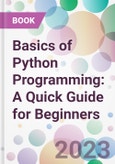Key Features:
Fundamental Focus: Covers the core concepts of Python programming to build a strong foundation in python programming in an easy-to-understand format.Practical Demonstrations: Learn by doing. This textbook includes hands-on practical demonstrations that reinforce your understanding of Python concepts.
IDE Guidance: Includes programming and installation guidance for Python-supporting Integrated Development Environments (IDEs).
Explores Python Frameworks: Introduces Python frameworks such as Matplotlib, TensorFlow, PyTorch, Scikit-Learn, and NLTK for complex projects.
Python for Machine Learning: Gives a preliminary understanding of Python for machine learning tasks for data science and AI applications.
Basics of Python Programming: A Quick Guide for Beginners is the perfect starting point for aspiring students, programmers and tech enthusiasts. Whether you're a student looking to build a solid foundation in Python or an industry professional venturing into machine learning and artificial intelligence, this textbook has you covered.
Readership
Computer science, engineering and technology students; programming enthusiasts and professionals.Table of Contents
- Contents
- Foreword
- Preface
- Introduction
- Technical Strengths of Python
- Portability
- Object-Oriented
- Community Support
- Advanced Features
- Memory Management
- Ease of Use
- Installing Python
- Windows Installer
- Ubuntu
- Linux Mint
- Python Idle
- Anaconda Open-Source Distribution
- Installing Anaconda on Windows
- Installing Anaconda on Linux
- First Python Program
- Python Keywords
- Identifiers
- Statements
- Indentation
- Comments
- Coding Styles
- Functional
- Imperative
- Procedural
- Object-Oriented
- Concluding Remarks
- Introduction
- Number
- Sequence
- Dictionary
- Boolean
- Set
- Type Conversion
- Implicit Type Conversion
- Explicit Type Conversion
- Operators
- Arithmetic Operators
- Addition (+) Operator
- Subtraction (-) Operator
- Multiplication (*) Operator
- Division (/) Operator
- Modulus (%) Operator
- Exponent (**) Operator
- Floor Division (//) Operator
- Relational Operators
- Greater Than (>) Operator
- Greater Than or Equal to (>=) Operator
- Less Than (<) Operator
- Less Than or Equal to (<=) Operator
- Equal to (==) Operator
- Not Equal to (! =) Operator
- Assignment Operator
- Assignment (=) Operator
- Add and (+=) Operator
- Subtract and (-=) Operator
- Multiply and (*=) Operator
- Divide and (/=) Operator
- Modulus and (%=) Operator
- Exponent and (**=) Operator
- Floor Division (//=) Operator
- Unary Operators
- Bitwise Operators
- Binary and (&) Operator
- Binary or (|) Operator
- Binary Xor (^) Operator
- Binary One's Complement (~) Operator
- Binary Left Shift (<<) Operator
- Binary Right Shift (>>) Operator
- Logical Operators
- Logical and Operator
- Logical or Operator
- Logical Not Operator
- Membership Operators
- Operator (In)
- Operator (Not)
- Identity Operators
- Operator (Is)
- Operator (Is Not)
- Operators' Precedence and Associativity
- Expressions
- Identifiers
- Literals
- Operators
- String Operations
- Accessing Values in Strings
- Triple Quotes
- Concluding Remarks
- Introduction
- Sequential Statements
- Decision Control Structures
- If Statements
- If-Else Statements
- Nested If
- If-Elif-Else
- Looping Statements
- For Loop
- While Loop
- Nested Loop
- Break Statement
- Continue Statement
- The Pass Statement
- Concluding Remarks
- Introduction
- Definition
- Predefined Functions
- User-Defined Functions
- Function Call
- Function Parameters and Arguments
- Default Arguments
- Variable Scope and Lifetime
- Scope of the Variable
- Local Scope
- Global Scope
- The Lifetime of the Variable
- Local and Global Variables
- Global Variables
- Global Statement
- Return Statement
- Lambda Functions
- Recursive Functions
- Function Redefinition
- Concluding Remarks
- Introduction
- String
- String Concatenation
- Using + Operator
- Using Join() Method
- Using % Operator
- Using Format() Function
- Appending Strings
- Using += Operator
- Using Join()
- Multiplying Strings
- Immutable Strings
- String Formatting Operator
- Built-In String Functions
- Slice Operation
- The Ord() Function
- The Chr() Function
- String Comparison
- Using Relational Operators
- Using is and is Not
- Using User-Defined Function
- Iterating String
- Split() Function
- Re.Findall() Function
- The String Module
- String Module Constants
- String.Ascii_Letters
- String.Ascii_Lowercase
- String.Ascii_Uppercase
- String.Digits
- String.Hexdigits
- String.Punctuation
- String Capwords() Function
- String Module Classes
- Formatter
- Template
- Regular Expression
- Lists
- Using List Index
- List Operations
- Updating Values in Lists
- Nested List
- Aliasing
- Cloning Lists
- Cloning List Using Slicing
- Cloning List Using Extend()
- Cloning List Using List()
- Cloning List Using List Comprehension
- Cloning List Using Append()
- Cloning List Using Copy()
- Built-In Functions
- List Built-In List Methods
- List as Arrays
- Loops in Lists
- For Loop in the List
- While Looping in the List
- List Comprehension
- Enumerate() Method
- Numpy in Loop
- List in Functions
- Concluding Remarks
- Introduction
- Tuple
- Thetuple ()Function
- Accessing Tuple
- Tuple Indexes
Author
- Krishna Kumar Mohbey
- Malika Acharya








